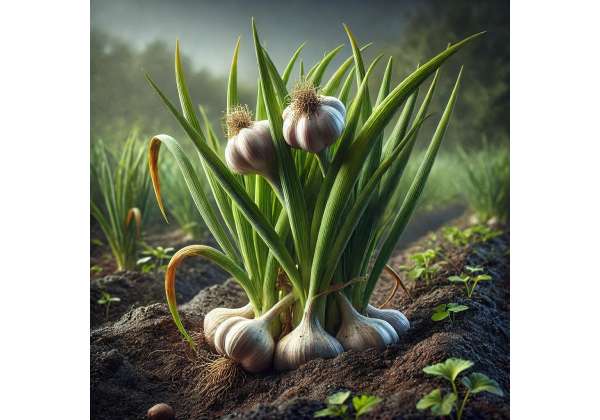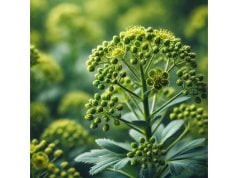
Garlic, known scientifically as Allium sativum, is a powerhouse herb that has been celebrated for centuries both as a flavorful culinary ingredient and as a natural remedy. Renowned for its pungent aroma and robust taste, garlic offers a wide range of health benefits—from supporting cardiovascular health and boosting immunity to reducing inflammation and combating infections. Its active compounds, particularly allicin, have been extensively researched for their antioxidant, antimicrobial, and anticancer properties. Whether used fresh, powdered, or as an extract, garlic remains a cornerstone in both kitchens and natural health practices around the globe. This comprehensive guide explores garlic’s botanical features, phytochemical profile, health benefits, practical applications, safety guidelines, and the latest scientific research.
Table of Contents
- Garlic Botany & Identification
- Garlic Phytochemical Composition & Key Ingredients
- Garlic Health Advantages & Core Properties
- Garlic Applications & Safety Measures
- Scientific Research & Notable Studies on Garlic
- Frequently Asked Questions
Garlic Botany & Identification
Garlic (Allium sativum) is a member of the Amaryllidaceae family and is closely related to onions, leeks, and chives. Originating in Central Asia, garlic has been cultivated for over 6,000 years and is now grown worldwide. It is a bulbous plant that produces a cluster of bulbs, each comprised of numerous cloves encased in a papery skin.
Taxonomy and Classification
- Family: Amaryllidaceae
- Genus: Allium
- Species: Allium sativum
- Common Names: Garlic, common garlic
Physical Characteristics
- Bulb and Cloves:
Garlic grows underground as a bulb that contains several cloves. Each clove is wrapped in a thin, dry skin and varies in size and flavor intensity. - Leaves:
The plant produces long, strap-like, green leaves that emerge from the base of the bulb. These leaves are often used as a culinary herb in some cultures. - Flowers:
In its flowering stage, garlic produces a tall, central stalk known as a scape, topped with an umbel of small, star-shaped white or pinkish flowers. However, most culinary garlic is harvested before the flowering stage to concentrate its flavor in the bulb. - Growth Habit:
Garlic forms dense clumps and prefers well-drained, fertile soils with a slightly acidic to neutral pH. It thrives in full sun and requires a cool period during its growth cycle to induce bulb formation.
Natural Habitat and Cultivation
Garlic is cultivated in temperate regions around the world and is adaptable to various climates. It is typically planted in the fall in colder regions to allow for a winter dormancy period, followed by vigorous growth in the spring. In milder climates, garlic can be planted in early spring. The plant’s robust nature and natural pest-resistant properties make it a favored crop in organic and sustainable agriculture.
Historical and Cultural Significance
Garlic’s storied past is as rich as its flavor. Ancient civilizations such as the Egyptians, Greeks, and Romans revered garlic not only for its culinary uses but also for its medicinal and mystical properties. It was used to enhance physical strength, ward off evil spirits, and even improve longevity. Today, garlic remains a staple ingredient in global cuisines and continues to be celebrated for its natural healing powers.
In summary, garlic’s botanical profile and adaptability have ensured its widespread cultivation and lasting presence in both culinary and medicinal traditions. Its distinct physical characteristics—from the multi-cloved bulb to its vibrant green leaves—are not only a delight to the senses but also a testament to its enduring value in human history.
Garlic Phytochemical Composition & Key Ingredients
The health benefits of garlic are largely attributed to its complex phytochemical makeup. Modern research has identified several bioactive compounds in garlic that work synergistically to deliver potent therapeutic effects. Below is a detailed overview of the primary active compounds found in garlic:
- Allicin
- Description:
Allicin is the most well-known compound in garlic and is produced when garlic cloves are crushed or chopped, converting alliin (a sulfur-containing compound) into allicin via the enzyme alliinase. - Role and Effects:
Allicin exhibits powerful antimicrobial, antiviral, and antifungal properties. It acts as an antioxidant, neutralizing free radicals and supporting cardiovascular health by improving blood circulation and reducing blood pressure.
- Alliin
- Description:
Alliin is a naturally occurring sulfur-containing compound present in intact garlic cloves. - Role and Effects:
Once garlic is damaged, alliin converts to allicin. Alliin itself contributes to the overall bioactivity of garlic, setting the stage for the formation of its potent derivatives.
- Ajoene
- Description:
Ajoene is a compound derived from allicin during the processing of garlic. - Role and Effects:
Known for its antithrombotic and anticancer properties, ajoene helps inhibit platelet aggregation and may contribute to a reduced risk of cardiovascular diseases. It also possesses antimicrobial qualities.
- Diallyl Disulfide (DADS)
- Description:
Diallyl disulfide is one of the major oil-soluble compounds found in garlic. - Role and Effects:
DADS is credited with anti-inflammatory and anticancer activities. It supports detoxification processes in the liver and aids in reducing oxidative stress.
- S-allyl cysteine (SAC)
- Description:
S-allyl cysteine is a water-soluble organosulfur compound found in aged garlic extracts. - Role and Effects:
SAC is known for its antioxidant properties, contributing to neuroprotection and cardiovascular health. It is also more stable and less irritating than allicin, making it beneficial in long-term supplementation.
- Flavonoids and Phenolic Compounds
- Description:
Garlic contains various flavonoids and phenolic acids, including quercetin and caffeic acid. - Role and Effects:
These compounds contribute to the herb’s antioxidant defense system, reducing cellular damage and inflammation, and supporting overall immune function.
- Minerals and Vitamins
- Description:
Garlic is a good source of essential nutrients, including vitamin C, vitamin B6, manganese, and selenium. - Role and Effects:
These nutrients support metabolic processes, enhance immune function, and contribute to bone health and enzyme activity.
The synergy among these compounds not only provides garlic with its distinct aroma and flavor but also underpins its wide array of health benefits. Their combined effects help reduce inflammation, support cardiovascular and immune health, and even contribute to cancer prevention, making garlic a true natural remedy.
Garlic Health Advantages & Core Properties
Garlic has been revered for centuries for its remarkable health-promoting properties. Modern research supports many of the traditional uses of garlic, underscoring its role as a natural remedy with multifaceted benefits. Below are the primary health advantages and inherent properties of garlic:
Key Health Benefits
- Cardiovascular Support:
Garlic is widely recognized for its heart-healthy properties. Its bioactive compounds help lower blood pressure, reduce cholesterol levels, and prevent plaque formation in the arteries. Allicin, in particular, is known to improve blood flow and reduce the risk of atherosclerosis. - Antimicrobial and Antiviral Activity:
Garlic’s potent antimicrobial properties are due to compounds like allicin, ajoene, and diallyl disulfide. These compounds help combat a wide range of pathogens, including bacteria, viruses, and fungi, making garlic a valuable natural defense against infections. - Antioxidant Defense:
The rich antioxidant profile of garlic, bolstered by flavonoids, phenolic compounds, and S-allyl cysteine, protects the body from oxidative stress. This reduces cellular damage and lowers the risk of chronic diseases such as cancer, diabetes, and neurodegenerative disorders. - Anti-Inflammatory Effects:
Garlic has powerful anti-inflammatory properties that can help reduce inflammation in conditions like arthritis and inflammatory bowel disease. Its ability to modulate inflammatory cytokines contributes to its therapeutic potential in managing chronic inflammation. - Immune System Enhancement:
Regular consumption of garlic has been linked to improved immune function. Its antimicrobial and antioxidant properties help fortify the body’s defenses against common infections and illnesses. - Cancer Prevention:
Studies suggest that garlic may have chemopreventive effects, particularly in reducing the risk of certain cancers such as stomach, colon, and prostate cancer. Its organosulfur compounds have been shown to induce apoptosis (programmed cell death) in malignant cells. - Detoxification and Liver Health:
Garlic supports liver detoxification processes by stimulating the production of detoxifying enzymes. This helps in the removal of toxins from the body and promotes overall metabolic health.
Additional Therapeutic Properties
- Respiratory Health:
Garlic’s expectorant properties can help alleviate symptoms of respiratory infections, including coughs and bronchitis, by aiding in the clearance of mucus. - Digestive Support:
By stimulating the production of digestive enzymes, garlic aids in better digestion and nutrient absorption, thereby reducing gastrointestinal discomfort. - Antithrombotic Effects:
Garlic helps prevent blood clot formation by reducing platelet aggregation, which supports overall cardiovascular health.
Mechanisms of Action
The myriad benefits of garlic can be attributed to its multifactorial mechanisms:
- Enzymatic Conversion:
The conversion of alliin to allicin when garlic is chopped or crushed triggers a cascade of bioactive compounds that exert antimicrobial and antioxidant effects. - Cellular Protection:
Antioxidants in garlic protect cell membranes and DNA from oxidative damage. - Inflammation Modulation:
Garlic compounds inhibit the production of pro-inflammatory cytokines and enzymes, thereby reducing inflammation. - Detoxification Enhancement:
The stimulation of liver enzymes by garlic aids in the efficient elimination of toxins, supporting overall metabolic balance.
Incorporating garlic into your diet can lead to a wide range of health improvements—from a stronger cardiovascular system and enhanced immunity to reduced inflammation and cancer prevention. Its potent bioactive properties make it a cornerstone of natural health and a valuable addition to both culinary and therapeutic regimens.
Garlic Applications & Safety Measures
Garlic is one of the most versatile herbs, serving as a culinary staple, a medicinal remedy, and a natural supplement in various forms. However, its potent bioactive compounds require careful use and proper dosage to ensure safety and effectiveness. This section outlines practical applications, preparation methods, dosage recommendations, and essential safety guidelines for garlic.
Practical Applications
- Culinary Uses:
Garlic is a fundamental ingredient in many cuisines worldwide. Its robust flavor can be used raw, sautéed, roasted, or incorporated into marinades and sauces. Crushing or chopping garlic releases allicin, enhancing its flavor and health benefits. - Tip: Use one to two cloves per serving, adjusting to taste.
- Herbal Teas and Infusions:
Garlic tea is traditionally consumed to support immune function and digestive health. A mild infusion made by steeping a crushed clove in hot water can help soothe respiratory symptoms and boost overall vitality. - Tip: Combine with honey or lemon to temper garlic’s pungency.
- Medicinal Preparations:
Garlic extracts and tinctures are popular in herbal medicine. These concentrated forms are used to harness garlic’s therapeutic properties for cardiovascular support, antimicrobial action, and cancer prevention. - Dosage: Follow standardized guidelines; for example, 300–1000 mg of aged garlic extract per day is commonly recommended.
- Supplement Forms:
Garlic is available in capsule and tablet form, which provide a controlled dosage of its bioactive compounds. These supplements are often standardized for allicin content. - Tip: Consult a healthcare provider for dosage tailored to your health needs.
- Topical Applications:
Garlic extracts are sometimes used in topical formulations for their antimicrobial and anti-inflammatory benefits. They may be found in creams or ointments designed for wound healing and skin health. - Caution: Always dilute garlic extract before applying to the skin to prevent irritation.
Preparation Methods and Dosage Recommendations
- Raw Garlic:
Crushing or chopping fresh garlic cloves is the most effective way to release allicin. It can be added to salads, dressings, and sauces. - Cooked Garlic:
Cooking garlic reduces its pungency and some of its bioactive compounds; however, it still provides nutritional benefits. - Aged Garlic Extract:
Aging garlic reduces its harshness and enhances its antioxidant properties. It is available in capsule form and is recommended for long-term health benefits. - Tinctures and Extracts:
Garlic tinctures should be used as directed, typically by diluting 10–15 drops in water or a carrier oil for internal or topical application. - Standard Dosage:
For cardiovascular and immune support, a daily dose of 300–1000 mg of aged garlic extract is generally recommended. For culinary use, one to two cloves per serving is effective.
Safety Considerations
- Digestive Sensitivity:
Some individuals may experience gastrointestinal discomfort, such as heartburn or gas, when consuming raw garlic. Start with small amounts and gradually increase intake. - Blood Thinning Effects:
Garlic’s antithrombotic properties can enhance blood thinning. Those on anticoagulant medication should consult with a healthcare provider before significantly increasing garlic consumption. - Allergic Reactions:
Although rare, garlic allergies can occur. Symptoms may include skin irritation or respiratory issues. Discontinue use if allergic reactions are observed. - Pregnancy and Lactation:
While culinary amounts are typically safe, concentrated garlic extracts should be used cautiously during pregnancy and lactation. Consultation with a healthcare provider is advised. - Interactions with Medications:
Garlic may interact with medications that affect blood clotting, blood pressure, or liver enzymes. It is important to discuss garlic supplementation with your healthcare provider if you are on prescription medications.
Best Practices for Safe Use
- Quality Control:
Choose high-quality garlic products from reputable sources to ensure consistent levels of active compounds. - Moderation:
Use garlic in moderation to maximize benefits while minimizing the risk of adverse effects. - Consultation:
Always consult a healthcare professional before beginning any new supplement regimen, especially if you have underlying health conditions. - Monitoring:
Pay attention to your body’s response and adjust your dosage if any side effects occur.
By adhering to these safety measures, you can enjoy the full spectrum of garlic’s benefits—both culinary and medicinal—while ensuring its potent compounds are used effectively and responsibly.
Scientific Research & Notable Studies on Garlic
Modern scientific research has extensively explored garlic’s therapeutic properties, validating many of its traditional uses. Below are several significant studies that illustrate the efficacy of garlic in various health contexts:
- Study on Cardiovascular Benefits (2015)
Publication: Journal of Nutrition
Study Name: “The Effects of Garlic Supplementation on Cardiovascular Risk Factors”
Key Findings:
This randomized controlled trial demonstrated that daily garlic supplementation significantly reduced blood pressure, lowered LDL cholesterol levels, and improved overall cardiovascular health in participants with elevated risk factors. The study attributes these effects primarily to allicin and its derivatives, which help relax blood vessels and inhibit cholesterol synthesis. The findings provide robust support for garlic’s role in preventing atherosclerosis and reducing the risk of heart disease. - Investigation of Antimicrobial Properties (2017)
Publication: International Journal of Antimicrobial Agents
Study Name: “Antibacterial Activity of Garlic Extracts Against Multidrug-Resistant Bacteria”
Key Findings:
Researchers evaluated the antibacterial efficacy of garlic extracts against a range of multidrug-resistant bacterial strains. The results indicated that garlic’s bioactive compounds, particularly allicin and ajoene, effectively inhibited bacterial growth. The study concluded that garlic could serve as a natural alternative or adjunct to conventional antibiotics, especially in an era of rising antibiotic resistance. - Evaluation of Anticancer Effects (2019)
Publication: Cancer Prevention Research
Study Name: “Garlic Consumption and Its Role in Cancer Prevention: A Meta-Analysis”
Key Findings:
This meta-analysis reviewed multiple studies on the relationship between garlic consumption and cancer risk. The analysis revealed a statistically significant inverse correlation between garlic intake and the incidence of several cancers, including those of the stomach, colon, and prostate. The anticancer effects are attributed to garlic’s ability to induce apoptosis in cancer cells and its antioxidant activity, which protects cellular DNA from damage. These findings underscore garlic’s potential as a chemopreventive agent and support its inclusion in a balanced diet for cancer risk reduction.
Collectively, these studies illustrate the diverse and powerful health benefits of garlic. They provide scientific validation for its use in cardiovascular protection, antimicrobial therapy, and cancer prevention, among other applications. Ongoing research continues to explore garlic’s mechanisms of action and optimal usage, promising even greater insights into this remarkable herb.
Frequently Asked Questions
What are the primary health benefits of garlic?
Garlic offers extensive health benefits, including cardiovascular support, antimicrobial and antiviral activity, antioxidant protection, anti-inflammatory effects, and potential anticancer properties. It helps lower blood pressure, improve cholesterol levels, and enhance overall immune function.
How can garlic be used in cooking?
Garlic is a staple in many cuisines, used raw, sautéed, roasted, or as a powdered spice. Crushing garlic releases allicin, which enriches the flavor of dishes like soups, stews, sauces, and marinades.
Is garlic safe for topical use?
Yes, when properly diluted, garlic extracts or essential oil can be used topically for their antimicrobial and anti-inflammatory benefits. Always perform a patch test to ensure no skin irritation or allergic reaction occurs.
Are there any precautions regarding garlic supplementation?
Garlic may interact with blood-thinning medications and can cause digestive discomfort in large amounts. It should be used in moderation, and individuals on medication or with underlying health conditions should consult a healthcare provider before supplementation.
Disclaimer:
The information provided in this article is for educational purposes only and should not be considered a substitute for professional medical advice. Always consult with a healthcare provider before using any herbal products or making changes to your wellness regimen.
Share this article on Facebook, X (formerly Twitter), or your preferred social media platform to help spread the word about the natural benefits and safe use of garlic!










